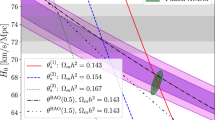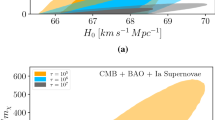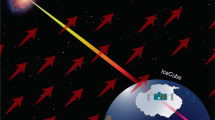Abstract
High-resolution maps of the temperature fluctuations in the cosmic microwave background radiation will provide valuable insight into the mechanism of structure formation in the early Universe. Theories involving inflation generally predict a pattern of gaussian (random) noise, whereas theories based on symmetry breaking and the generation of defects—such as strings, textures and monopoles—have more distinctive signatures. Degree-scale measurements of the microwave background currently in progress should provide a powerful test of these competing theories.
This is a preview of subscription content, access via your institution
Access options
Subscribe to this journal
Receive 51 print issues and online access
$199.00 per year
only $3.90 per issue
Buy this article
- Purchase on Springer Link
- Instant access to full article PDF
Prices may be subject to local taxes which are calculated during checkout
Similar content being viewed by others
References
Kibble, T. W. B. J. Phys. A9, 1387–1398 (1976).
Kaiser, N. & Stebbins, A. Nature 310, 391–393 (1984).
Turok, N. & Spergel, D. Phys. Rev. Lett. 64, 2736–2739 (1990).
Turok, N. Physica Scripta T36, 135–141 (1991).
Smoot, G. F. et al., Astrophys. J. 396, L1–L5 (1992).
Bennett, D. P. & Rhie, S. H. Astrophys. J. 406, L7–L10 (1993).
Pen, U., Spergel, D. & Turok, N. Phys. Rev. D49, 692–729 (1994).
Gundersen, J. O. et al. Astrophys. J. 413, L1–L5 (1993).
Meinhold, P. et al. Astrophys. J. 409, L1–L4 (1993).
Schuster, J. et al. Astrophys. J. 412, L47–L50 (1993).
Graham, P., Turok, N., Lubin, P. M. & Schuster, J. Astrophys. J. (in the press).
Dragovan, M. et al. Astrophys. J. (in the press).
Gaier, T. et al. Astrophys. J. 398, L1–L4 (1992).
Silk, J. & Tegmark, M. Astrophys. J. (in the press).
Fukugita, M. & Kawasaki, M. Tokyo Univ. Report No. 301-93-13 (1993).
Gibbons, G., Hawking, S. & Vachaspati, T. (eds) The Formation and Evolution of Cosmic Strings (Cambridge Univ. Press, 1990).
Smith, G. & Vilenkin, A. Phys. Rev. D36, 990–996 (1987).
Sakellariadou, M. & Vilenkin, A. Phys. Rev. D42, 349–353 (1990).
Bouchet, F., Bennett, D. P. & Stebbins, A. Nature 335, 410–414 (1988).
Peebles, P. J. E. Astrophys. J. 315, L73–L75 (1987).
Peebles, P. J. E. Principles of Physical Cosmology (Princeton Univ. Press, 1993).
Crittenden, R., Bond, J. R., Davis, R. L., Efstathiou, G. P. & Steinhardt, P. J. Phys. Rev. Lett. 71, 324–327 (1993).
Wright, E. et al. COBE preprint No. 93-06 (Goddard Space Flight Center, Greenbelt, 1993).
Author information
Authors and Affiliations
Rights and permissions
About this article
Cite this article
Coulson, D., Ferreira, P., Graham, P. et al. Microwave anisotropies from cosmic defects. Nature 368, 27–31 (1994). https://doi.org/10.1038/368027a0
Received:
Accepted:
Issue Date:
DOI: https://doi.org/10.1038/368027a0
This article is cited by
-
On the Inverse Problem of Finding Cosmic Strings and Other Topological Defects
Communications in Mathematical Physics (2018)
-
Tests and Problems of the Standard Model in Cosmology
Foundations of Physics (2017)
-
Non-Abelian Multiple Vortices in Supersymmetric Field Theory
Communications in Mathematical Physics (2011)
-
Some doubts on the validity of the foreground Galactic contribution subtraction from microwave anisotropies
Journal of Astrophysics and Astronomy (2007)
-
The physics of microwave background anisotropies
Nature (1997)
Comments
By submitting a comment you agree to abide by our Terms and Community Guidelines. If you find something abusive or that does not comply with our terms or guidelines please flag it as inappropriate.



